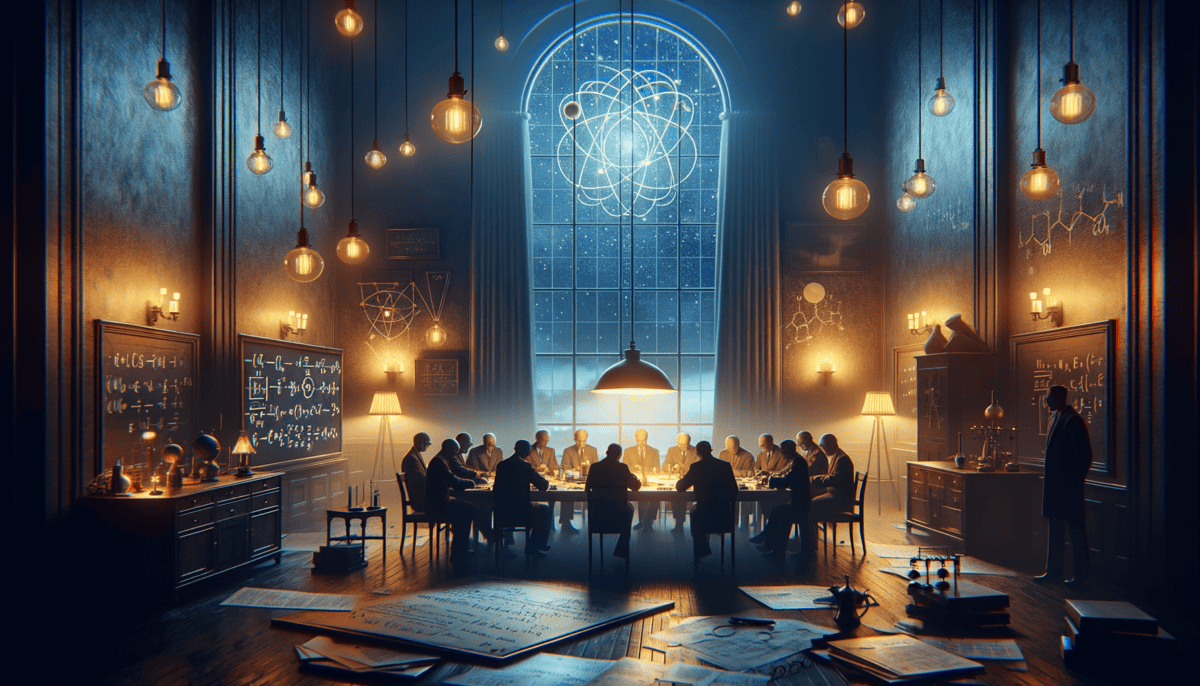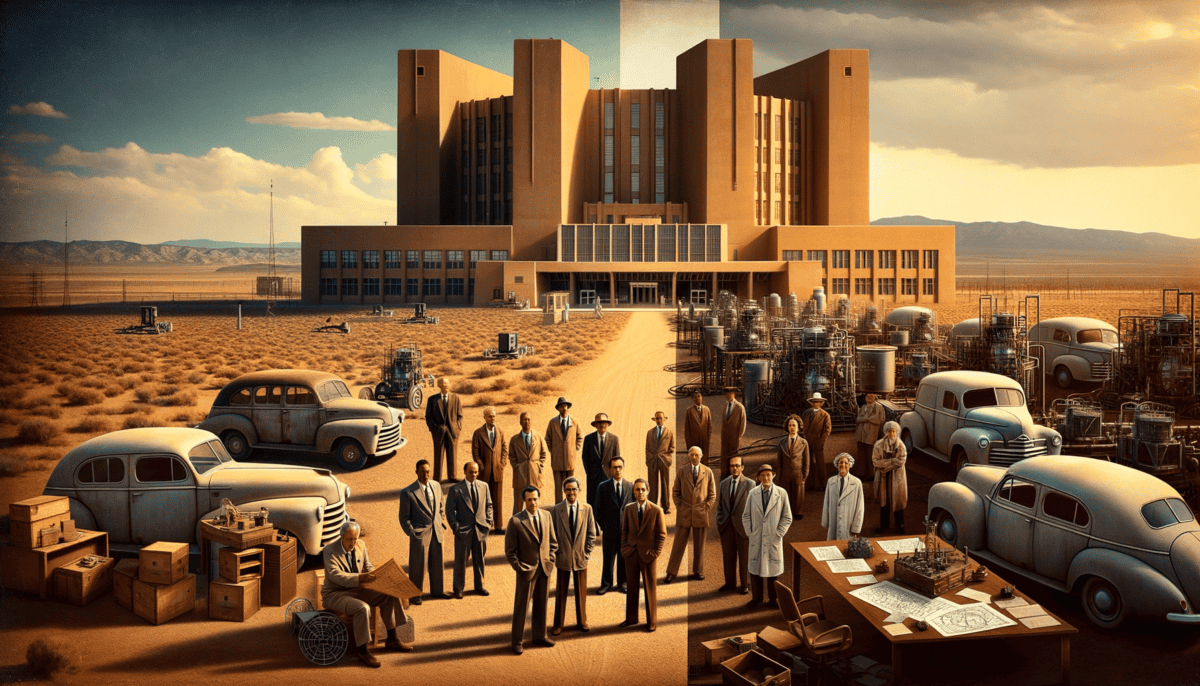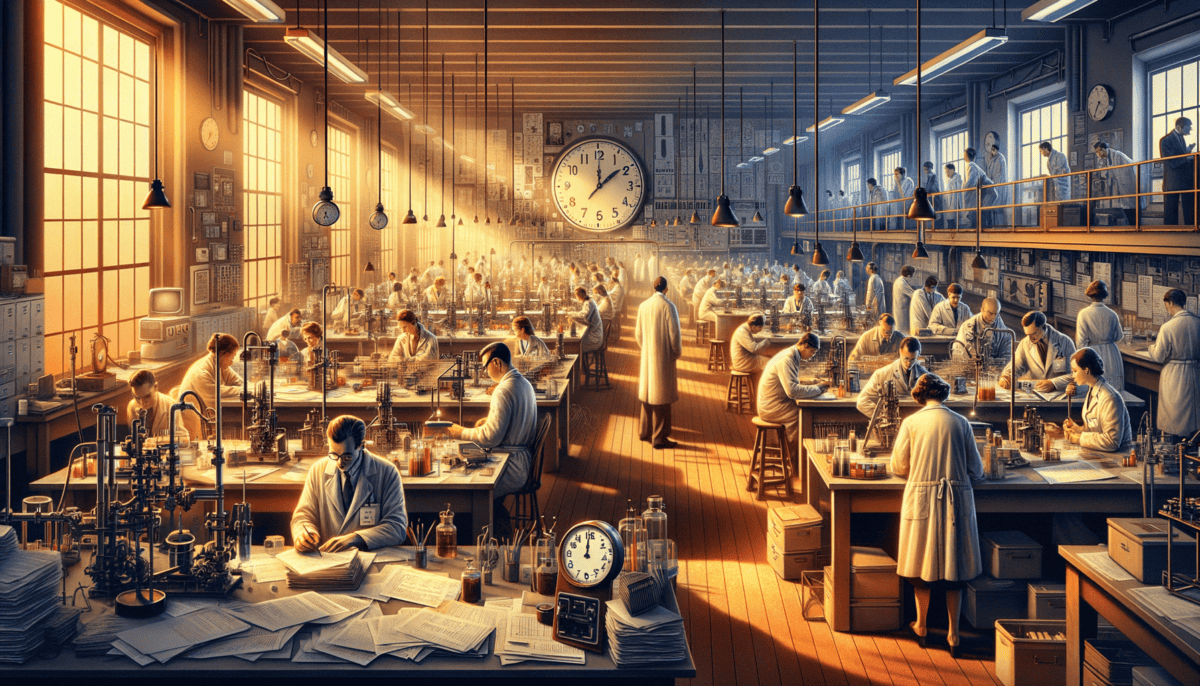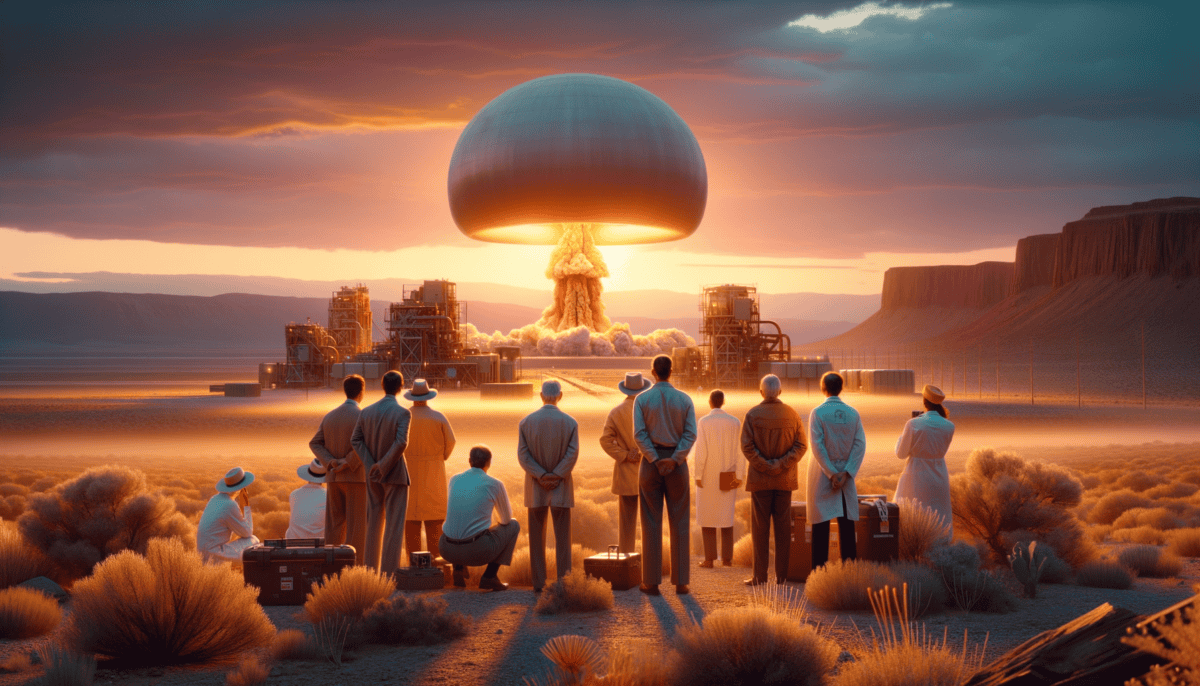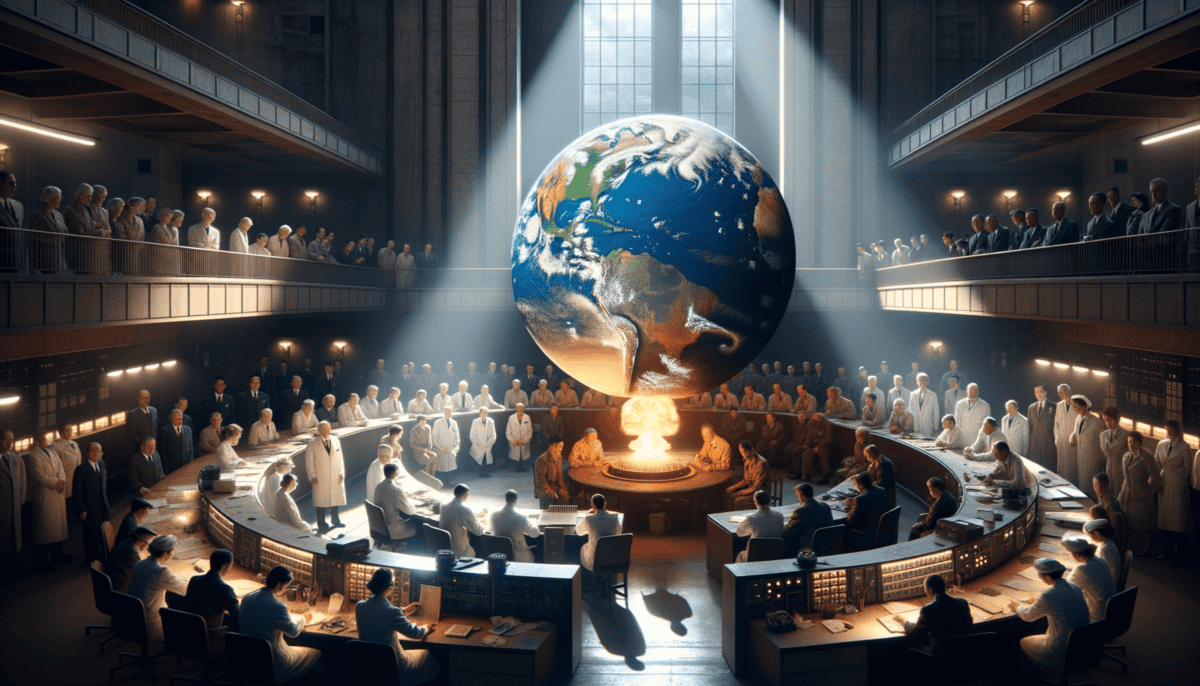The Warning
On a warm summer day in 1939, two scientists walked down a quiet street in Long Island. They were worried. Very worried.
Albert Einstein sat in his beach chair, enjoying the sunshine. His wild white hair moved in the breeze. Then he saw his friend Leo Szilard walking up to his house. Leo's face looked scared.
"Albert, we need to talk," Leo said, wringing his hands. "The Germans – they might be working on something terrible."
Einstein sat up straight. He knew that Nazi Germany was becoming stronger. But what could be so scary that it made Leo look this worried?
"What is it, Leo?" Einstein asked.
Leo took a deep breath. "They might be trying to make a super powerful bomb. One that could destroy an entire city!"
Einstein's eyes got wide. He knew what Leo meant. Scientists had recently learned that tiny things called atoms could release huge amounts of energy. In the wrong hands, this could be very dangerous.
"We must warn President Roosevelt," Einstein said firmly. "America needs to know about this danger."
That very day, Einstein and Leo started writing a very important letter. They wrote:
“Dear Mr. President,
Scientists have found that atoms can make a lot of energy. This could be used to make very powerful bombs. We think Germany might be trying to make these bombs. America should start working on this too, just to be safe.”
President Roosevelt got the letter a few weeks later. At first, he wasn't sure what to think. Could atoms really be that powerful?
He called in some smart people to help him understand. They explained how atoms could indeed make big explosions. The President started to worry too.
"If Germany gets these bombs first, they could win the war," one advisor said. "We need to start working on this right away!"
A Big Decision
President Roosevelt made a big choice. America would try to make these atomic bombs before Germany could. But it had to be super secret.
He put together a special team. They would work on something called "The Manhattan Project." Even though it wasn't in Manhattan at all! The name was just to trick people.
Einstein felt both happy and sad. Happy that America would be prepared. But sad that his science might be used to hurt people. He wrote in his diary that night: "I hope we are doing the right thing."
The warning had been given. Now, America would start the biggest secret science project ever. Nobody knew then how much this would change the world.
Leo looked back at Einstein's house as he walked home that evening. The sun was setting, making everything look orange and peaceful. But both men knew that peaceful times might not last much longer.
In Washington D.C., President Roosevelt put Einstein's letter in his desk drawer. He picked up his phone and started making calls. The race to build the world's most powerful weapon had begun.
The Search for Super Scientists
The government needed the smartest scientists in America. They chose Dr. Robert Oppenheimer to lead them. He was tall and thin, with bright eyes that showed how smart he was.
“We need the best minds in the country,” Oppenheimer said to General Leslie Groves, who was in charge of the whole project. “And we need them fast!”
Building the Dream Team
Like a coach picking players for a super-important game, Oppenheimer started choosing his team. He called his friend Edward Teller first.
“Edward, I need your help with something big,” Oppenheimer said on the phone. “But you can’t tell anyone about it.”
Soon, more scientists joined the team:
- Enrico Fermi, who was really good at making atoms split
- Richard Feynman, who could solve really hard math problems
- Hans Bethe, who knew all about how stars make energy ⭐
But keeping everything secret was hard! The scientists couldn’t even tell their families what they were working on.
“Where are you going, daddy?” asked one scientist’s little girl.
“I’m going to do important work to help our country,” was all he could say.
Finding Secret Places
They needed special places to work where nobody would find them. General Groves picked three main spots:
Oak Ridge in Tennessee
Hanford in Washington State
Los Alamos in New Mexico ️
Los Alamos was the most special place. It sat on top of a mountain, far away from any cities. The scientists called it “The Hill.” Nobody could visit without special permission.
“It’s perfect,” Oppenheimer said when he first saw it. “Nobody will find us here.”
Working Together
The scientists had to learn to work as a team. Sometimes they didn’t agree on how to solve problems. But Oppenheimer was good at helping them get along.
“Think of it like a big puzzle,” he would say. “Each of you has a different piece to solve.”
They worked day and night. Some scientists missed their families. Others worried about what they were making. But they all knew their work was important.
As winter turned to spring in 1943, the team grew bigger and stronger. But their hardest work was still ahead. They had to turn their ideas into something real – something that had never been made before.
Every night, Oppenheimer would look out his window at the lights of Los Alamos. He could see his scientists still working late, trying to unlock the secrets of the atom. The race against time was getting faster, and they couldn’t slow down.
The building full of brilliant minds buzzed with energy and ideas. Tomorrow would bring new challenges, but for now, the team was ready to face them together.
The Secret Mountain Lab
High up in the mountains of New Mexico, a new city was growing. Los Alamos wasn’t on any maps. The scientists called it “The Hill.” ️
Dr. Oppenheimer stood at his office window, watching trucks bring more equipment. “This will be our new home,” he said to his team.
Life on The Hill
Scientists and their families lived in simple houses. The roads were muddy when it rained. But nobody complained – they were too busy with their important work.
“Daddy, why can’t I tell my friends where we live?” asked a little girl.
“It’s like we’re superheroes,” her father answered. “We have to keep our hideout secret.” ♂️
Breaking the Atom
In big labs, scientists worked with tiny things called atoms. They needed to split them apart to make energy. It was like trying to crack the world’s hardest puzzle.
“Each experiment teaches us something new,” Dr. Fermi told his team. “Even when things go wrong, we learn.”
They had special machines to make uranium pure. Uranium was a special metal they needed for their work. Making it pure was like trying to find one specific grain of sand on a beach! ️
Scientists worked long hours solving problems no one had solved before. Sometimes their machines broke. Sometimes their ideas didn’t work. But they never gave up!
Working Together
Different teams worked on different parts of the project. Some people did math problems. Others built machines. Everyone had an important job.
Richard Feynman made a game of breaking into safes where secret papers were kept. He wanted to show how important it was to keep things safe!
“Remember,” Oppenheimer would say at meetings, “we’re all working together to help our country.”
Special Moments
Even with all the hard work, the scientists found time to have fun. They had square dances in the evening. Kids played in the desert and climbed mountains.
But time was running out. The war in Europe was getting worse. Everyone knew their work had to go faster.
One night, after a long day of experiments, Dr. Oppenheimer walked home under the stars. The lights of Los Alamos glowed behind him. He thought about all the smart people working together, all the progress they were making.
“We’re getting closer,” he whispered to himself. “We’re getting closer every day.”
Back in the labs, machines hummed through the night. Scientists worked by lamplight, writing equations and checking numbers. The biggest scientific project in history was moving forward, hidden away on a secret mountain in New Mexico.
The next morning would bring new challenges, new problems to solve. But for now, The Hill was quiet under its blanket of stars.
The Great Race
The wind howled outside the Los Alamos labs as Dr. Oppenheimer read a secret report. Other countries were trying to make atomic bombs too!
Spy Games
“We need to know what the Germans are doing,” General Groves said during a meeting. Special agents called spies were sent to Europe to find out. ️♂️
One brave spy named Moe Berg pretended to be a baseball player. He went to Europe and took pictures of secret German labs!
“Every day counts,” Dr. Oppenheimer told his team. “We must solve these puzzles before anyone else does.”
Big Problems, Big Solutions
The scientists faced many hard problems. Making the atomic bomb work was like building a thousand puzzles at once!
“The uranium isn’t pure enough,” Dr. Fermi said one day, shaking his head.
“Then we’ll try again,” answered Dr. Lawrence. “And again, until we get it right!”
Heavy Hearts
Many scientists felt worried about what they were making. They knew their work could hurt many people.
“Are we doing the right thing?” Dr. Wilson asked during lunch.
“We must stop Hitler,” another scientist answered. “Before he makes these weapons first.”
Working Harder
The days grew longer. Scientists worked through nights. Some slept in their labs, not wanting to waste time going home. ⏰
• More pure uranium
• Better bomb designs
• Faster calculations
• Stronger materials
Family Life
While parents worked in the labs, kids went to school in Los Alamos. They couldn’t tell anyone where they lived or what their parents did.
“Why do you look so tired, Daddy?” a little boy asked.
“I’m helping make something very important,” his father answered. “Something to help end the war.”
Racing Forward
Each week brought new progress. The uranium got purer. The designs got better. The calculations got more accurate.
“We’re not just racing against other countries,” Dr. Oppenheimer said. “We’re racing against time itself.”
One evening, as the sun set behind the mountains, Dr. Oppenheimer stood with his team. They watched as a test machine worked perfectly for the first time.
“Look how far we’ve come,” he said proudly. “But we still have far to go.”
The lights in the labs stayed on late that night, as they did every night. The race continued, hidden away on their secret mountain. The biggest question remained: Who would win? ♂️
The Day That Changed Everything
The sun rose early on July 16, 1945. Scientists gathered in the New Mexico desert. Today was the big test they called “Trinity.”
Getting Ready
Dr. Oppenheimer looked up at the tall tower. On top sat their creation – a big metal ball with the atomic bomb inside.
“Is everything ready?” he asked.
“Yes, sir,” answered Dr. Kistiakowsky. “All the wires are connected.”
“Now we become death, the destroyer of worlds,” Dr. Oppenheimer whispered to himself.
The Wait
Scientists went to special bunkers far from the tower. They wore dark glasses to protect their eyes. ⏰
“Ten minutes until test time,” came the voice over the radio.
Dr. Fermi stood ready with some paper. He wanted to see how far the blast would push it.
The Big Moment
The countdown started: “5… 4… 3… 2… 1…”
FLASH! A light brighter than the sun lit up the dark morning.
BOOM! The sound was louder than anything they’d heard before.
A huge cloud shaped like a mushroom rose into the sky. It went up and up, higher than anyone expected.
After the Flash
The scientists had many different feelings:
• Some cheered
• Some cried
• Some prayed
• Some stayed quiet
“It worked,” Dr. Oppenheimer said softly. His hands were shaking.
The Desert Changed
Where the tower had been, there was now just melted sand. The heat had turned it into green glass! ️
“The bomb was stronger than we thought,” Dr. Teller said, looking at his measurements.
The test had worked better than anyone expected. But this made many scientists worry more.
Big Decisions
General Groves wrote a message to President Truman right away: “The test was a success.”
“Now we must decide what to do with this power,” Dr. Oppenheimer told his team.
As they drove back to Los Alamos, the giant mushroom cloud still hung in the sky. The world had changed forever on this desert morning. No one would ever forget what they saw. ☁️
The Power That Changed Our World
After the Trinity test, everything moved quickly. President Truman had a big decision to make.
Two Cities
On August 6, 1945, a plane called the Enola Gay flew over Japan. It dropped an atomic bomb on Hiroshima. Three days later, another bomb fell on Nagasaki.
“What have we done?” Dr. Oppenheimer asked when he heard the news.
“Science has known sin,” he wrote in his diary that night.
The War Ends
The bombs made Japan stop fighting. World War II was finally over. But the cost was very high. Many people lost their lives. ️
“We must never use these weapons again,” Einstein said when he learned what happened.
The Scientists Think About What They Did
• Some felt proud they helped end the war
• Others felt sad about the destruction
• Many wanted to use atomic power for peace instead
A New World
The Manhattan Project changed everything. Countries now knew about atomic power. They started making their own bombs.
“We must be careful with this new power,” Dr. Oppenheimer told Congress. “It can help us or hurt us.”
Learning From The Past
Today, we still think about the Manhattan Project. It shows us how smart people working together can do amazing things. But it also teaches us to be careful with powerful new discoveries.
“The atom is like fire,” Einstein said. “It can cook our food or burn our house down. We must choose how to use it.”
Looking Forward
Scientists now use atomic power to make electricity and help sick people. They try to use their knowledge to make life better, not worse.
Dr. Oppenheimer spent the rest of his life talking about using science for peace. He wanted everyone to learn from what happened.
The world learned a big lesson from the Manhattan Project. We must be wise when we use new discoveries. We must think about how they affect everyone, not just ourselves.
The story of the Manhattan Project will always remind us to use our knowledge to help, not harm. It shows us that the choices we make today can change tomorrow for everyone.


